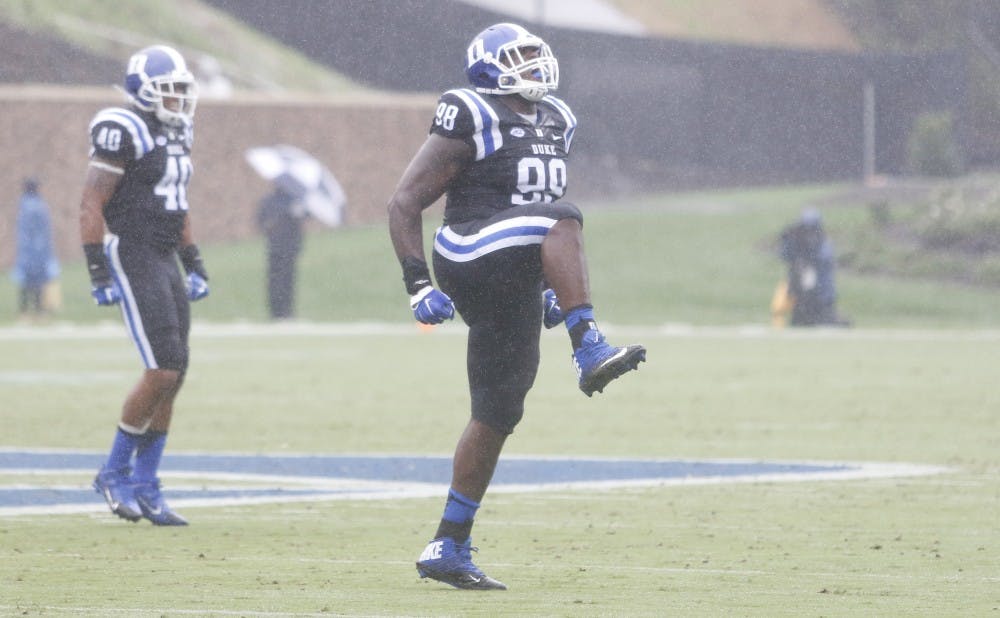We’re now one-third of the way through the regular season, but in many ways it feels as if three entirely different Blue Devil teams have taken the field for the first four games.
There was the smooth-operating offense that characterized the two blowouts to kick off the season, when Thomas Sirk stepped into the starting quarterback slot with ease. Then there was the egg against Northwestern, when Duke’s trusted special teams let it down and the offense forgot how to attack downfield. And finally, we saw a reinvigorated Blue Devil squad Saturday—one with Shaquille Powell bursting through holes on offense, the defense flying around making plays and the special teams unit returning to form with a pair of monster returns.
But amidst all the questions that remain, one thing is for certain—Duke’s defense is for real.
After sparking the upset of then-No. 20 Georgia Tech to open ACC play, the Blue Devil defense ranks in the top 10 in the nation in both scoring and total defense—ahead of vaunted defenses like Alabama’s—and No. 3 in ESPN’s defensive efficiency stat, which accounts for quality of opponent and game situations.
In some ways, Duke’s excellence on the defensive side of the ball is a surprise, and in others, it’s not. The linebacking corps looked thin after the graduation of leading tackler David Helton and a career-ending ACL injury to Kelby Brown, but a pair of returning All-Americans in the secondary in Jeremy Cash and DeVon Edwards brightened the outlook a bit for defensive coordinator Jim Knowles. With questions in abundance on the offensive side of the ball, the defense was expected to shoulder the bulk of the load—and it’s done more than that thus far.
Through four games, the Blue Devils rank seventh in the country, allowing just 11.5 points per game—just more than half of last year’s 21.8 mark. The defense itself has actually let up less than 10 points per game, once you remove the kickoff return touchdown by Northwestern from the official figures.
With just one of 10 defensive linemen weighing in at more than 300 pounds, Duke is an undersized unit up front, and its opponents have taken notice. Teams have tried to avoid the Blue Devils’ strong secondary and instead attack a relatively inexperienced defensive line. Duke’s opponents have run the ball 58.9 percent of the time thus far, but without much success thanks to the Blue Devils’ uncanny ability to knife through blocking schemes and wreak havoc in the backfield.
The raw figure of 113.3 rushing yards per game looks like a pretty solid offensive figure, but that figure gets trimmed to a more defensive-leaning average of 2.8 yards per carry. Duke held the Yellow Jackets’ top-ranked rushing attack to a measly 2.9 yards per rush—Georgia Tech’s lowest mark since 2011—and 200 yards fewer than its season average.
Keep in mind that more than two-thirds of the rushing attempts against the Blue Devils have come from Georgia Tech’s finely-tuned triple-option offense and a ground-and-pound Northwestern squad that boasts a returning 1,000-yard rusher in sophomore Justin Jackson. In their other games this year, Tulane, N.C. Central, Northwestern and Georgia Tech have averaged better than five yards per carry and nearly 250 yards on the ground—meaning their production has fallen by more than 50 percent against the Blue Devils.
Even when they try to attack Duke’s staunch secondary, opponents have had great difficulty moving the ball and putting up points. The Blue Devils have allowed just two passing touchdowns thus far—one of which was a garbage time score by the Green Wave—holding opponents to less than one-third of their aerial scoring output from all other games.
Tulane’s Tanner Lee has been the only signal-caller to eclipse the 50 percent completion mark with his 24-of-42 performance, but, again, most of that came when the game’s outcome was already safely decided. The Blue Devils have held opposing quarterbacks to a 44.8 percent completion rate, compared to the 59.4 percent rate those passers have posted against all other foes this season.
Thanks primarily to its ability to keep opposing quarterbacks from completing passes at any kind of productive rate, Duke has yielded less than five yards per passing attempt—or more than a full yard less than beleaguered Jacksonville Jaguars quarterback Blake Bortles threw for last year—and fewer than 150 passing yards per game.
Next up for Duke is Boston College as the Blue Devils try to move to 2-0 in conference play. We can’t know which version of Sirk will show up at Wallace Wade this Saturday, but we can be sure the defense will be there in full force. Nobody is going to confuse them with the 1985 Chicago Bears anytime soon, but the Blue Devils’ defense is starting to look like one of the elite units in all of college football.

